warning light JEEP GRAND CHEROKEE 2012 WK2 / 4.G Owner's Manual
[x] Cancel search | Manufacturer: JEEP, Model Year: 2012, Model line: GRAND CHEROKEE, Model: JEEP GRAND CHEROKEE 2012 WK2 / 4.GPages: 148, PDF Size: 5.91 MB
Page 96 of 148
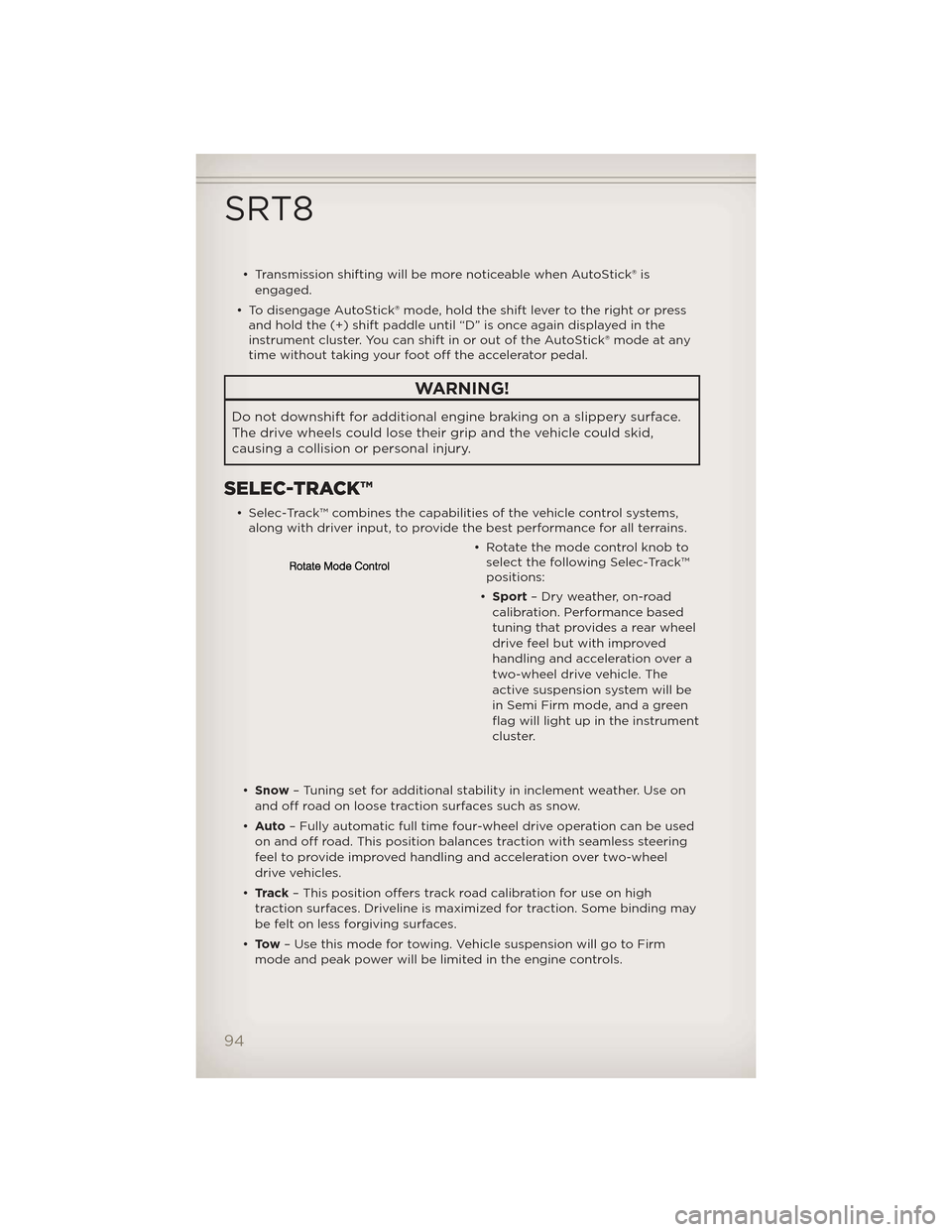
• Transmission shifting will be more noticeable when AutoStick® isengaged.
• To disengage AutoStick® mode, hold the shift lever to the right or press and hold the (+) shift paddle until “D” is once again displayed in the
instrument cluster. You can shift in or out of the AutoStick® mode at any
time without taking your foot off the accelerator pedal.
WARNING!
Do not downshift for additional engine braking on a slippery surface.
The drive wheels could lose their grip and the vehicle could skid,
causing a collision or personal injury.
SELEC-TRACK™
• Selec-Track™ combines the capabilities of the vehicle control systems,along with driver input, to provide the best performance for all terrains.
• Rotate the mode control knob toselect the following Selec-Track™
positions:
• Sport – Dry weather, on-road
calibration. Performance based
tuning that provides a rear wheel
drive feel but with improved
handling and acceleration over a
two-wheel drive vehicle. The
active suspension system will be
in Semi Firm mode, and a green
flag will light up in the instrument
cluster.
• Snow – Tuning set for additional stability in inclement weather. Use on
and off road on loose traction surfaces such as snow.
• Auto – Fully automatic full time four-wheel drive operation can be used
on and off road. This position balances traction with seamless steering
feel to provide improved handling and acceleration over two-wheel
drive vehicles.
• Track – This position offers track road calibration for use on high
traction surfaces. Driveline is maximized for traction. Some binding may
be felt on less forgiving surfaces.
• To w – Use this mode for towing. Vehicle suspension will go to Firm
mode and peak power will be limited in the engine controls.
SRT8
94
Page 99 of 148
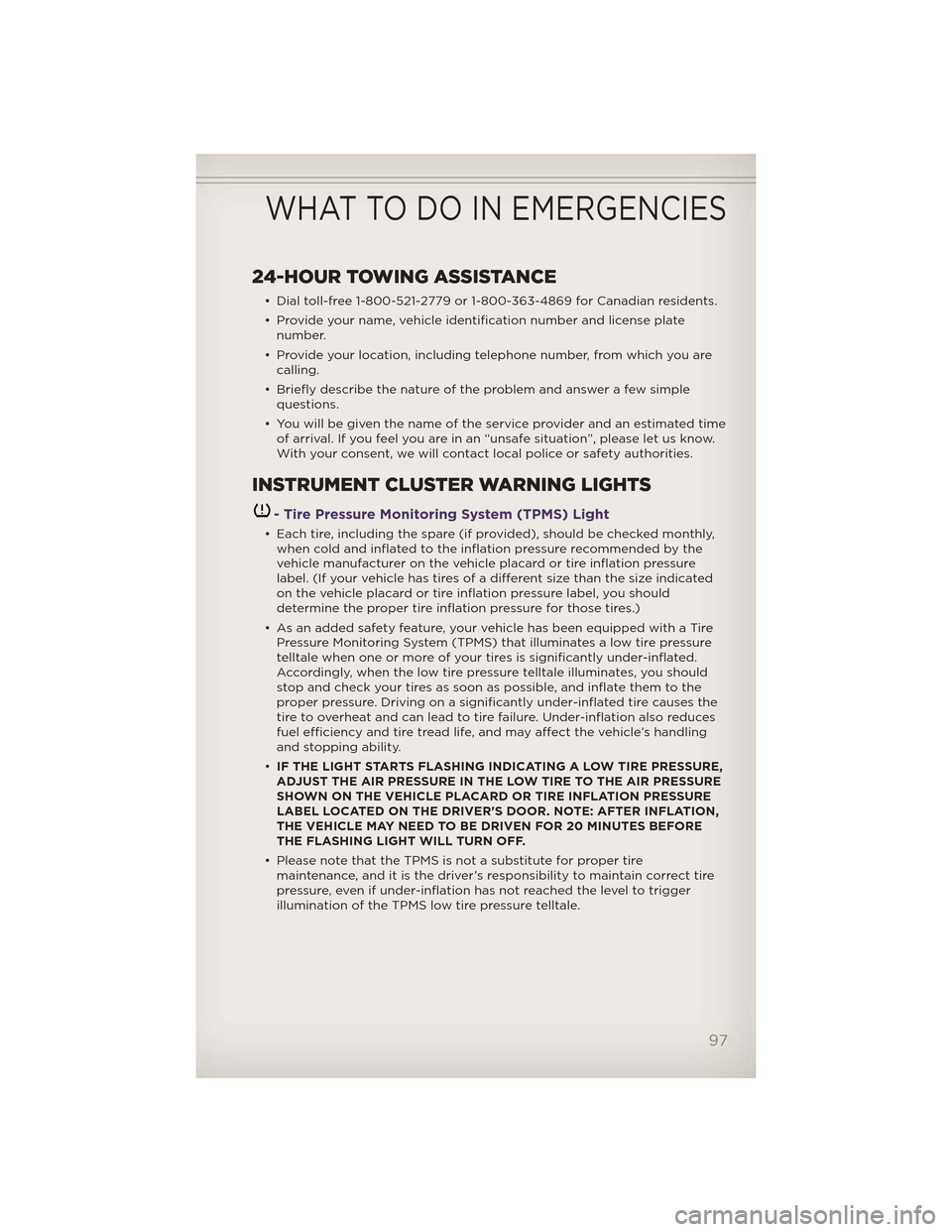
24-HOUR TOWING ASSISTANCE
• Dial toll-free 1-800-521-2779 or 1-800-363-4869 for Canadian residents.
• Provide your name, vehicle identification number and license platenumber.
• Provide your location, including telephone number, from which you are calling.
• Briefly describe the nature of the problem and answer a few simple questions.
• You will be given the name of the service provider and an estimated time of arrival. If you feel you are in an “unsafe situation”, please let us know.
With your consent, we will contact local police or safety authorities.
INSTRUMENT CLUSTER WARNING LIGHTS
- Tire Pressure Monitoring System (TPMS) Light
• Each tire, including the spare (if provided), should be checked monthly,when cold and inflated to the inflation pressure recommended by the
vehicle manufacturer on the vehicle placard or tire inflation pressure
label. (If your vehicle has tires of a different size than the size indicated
on the vehicle placard or tire inflation pressure label, you should
determine the proper tire inflation pressure for those tires.)
• As an added safety feature, your vehicle has been equipped with a Tire Pressure Monitoring System (TPMS) that illuminates a low tire pressure
telltale when one or more of your tires is significantly under-inflated.
Accordingly, when the low tire pressure telltale illuminates, you should
stop and check your tires as soon as possible, and inflate them to the
proper pressure. Driving on a significantly under-inflated tire causes the
tire to overheat and can lead to tire failure. Under-inflation also reduces
fuel efficiency and tire tread life, and may affect the vehicle’s handling
and stopping ability.
• IF THE LIGHT STARTS FLASHING INDICATING A LOW TIRE PRESSURE,
ADJUST THE AIR PRESSURE IN THE LOW TIRE TO THE AIR PRESSURE
SHOWN ON THE VEHICLE PLACARD OR TIRE INFLATION PRESSURE
LABEL LOCATED ON THE DRIVER'S DOOR. NOTE: AFTER INFLATION,
THE VEHICLE MAY NEED TO BE DRIVEN FOR 20 MINUTES BEFORE
THE FLASHING LIGHT WILL TURN OFF.
• Please note that the TPMS is not a substitute for proper tire maintenance, and it is the driver’s responsibility to maintain correct tire
pressure, even if under-inflation has not reached the level to trigger
illumination of the TPMS low tire pressure telltale.
WHAT TO DO IN EMERGENCIES
97
Page 100 of 148
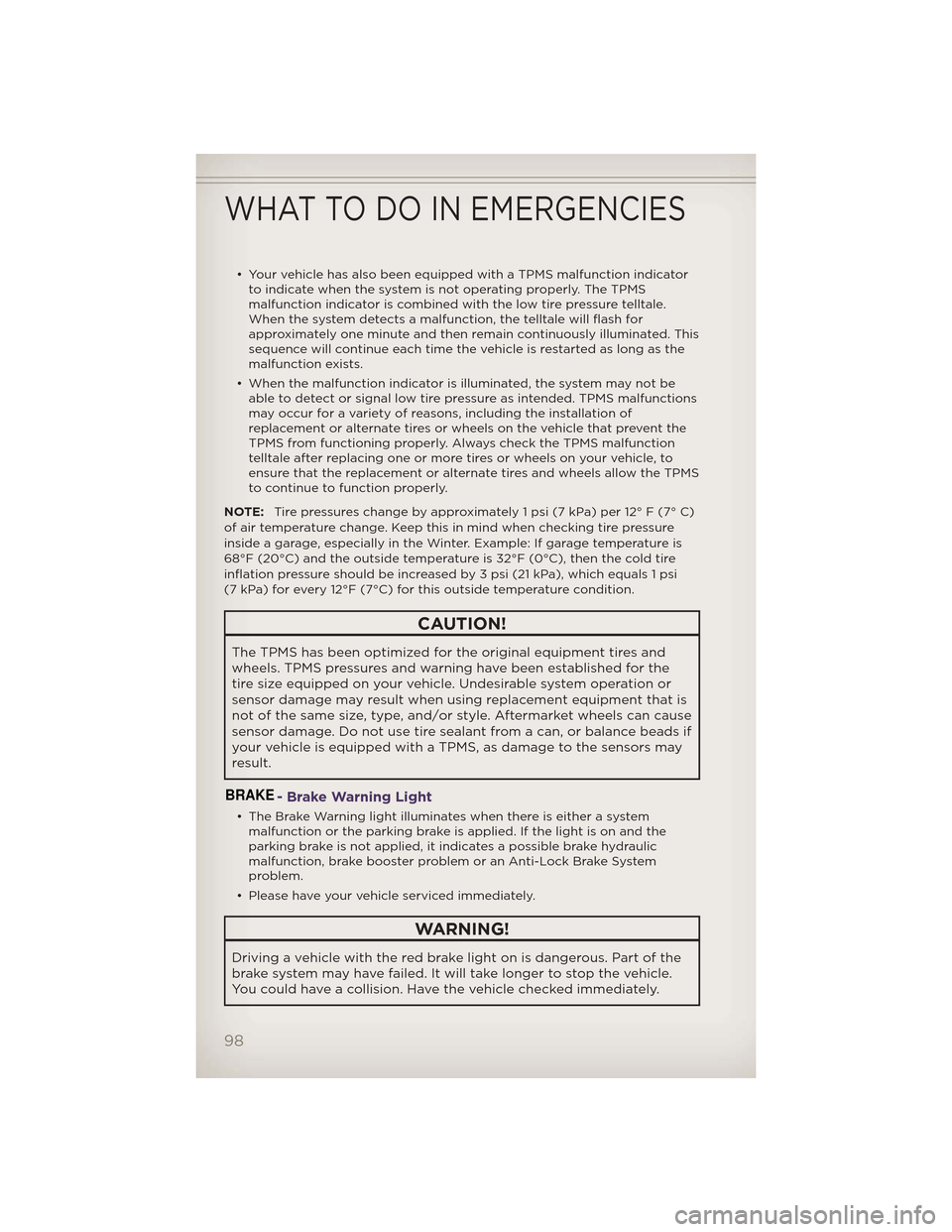
• Your vehicle has also been equipped with a TPMS malfunction indicatorto indicate when the system is not operating properly. The TPMS
malfunction indicator is combined with the low tire pressure telltale.
When the system detects a malfunction, the telltale will flash for
approximately one minute and then remain continuously illuminated. This
sequence will continue each time the vehicle is restarted as long as the
malfunction exists.
• When the malfunction indicator is illuminated, the system may not be able to detect or signal low tire pressure as intended. TPMS malfunctions
may occur for a variety of reasons, including the installation of
replacement or alternate tires or wheels on the vehicle that prevent the
TPMS from functioning properly. Always check the TPMS malfunction
telltale after replacing one or more tires or wheels on your vehicle, to
ensure that the replacement or alternate tires and wheels allow the TPMS
to continue to function properly.
NOTE: Tire pressures change by approximately 1 psi (7 kPa) per 12° F (7° C)
of air temperature change. Keep this in mind when checking tire pressure
inside a garage, especially in the Winter. Example: If garage temperature is
68°F (20°C) and the outside temperature is 32°F (0°C), then the cold tire
inflation pressure should be increased by 3 psi (21 kPa), which equals 1 psi
(7 kPa) for every 12°F (7°C) for this outside temperature condition.
CAUTION!
The TPMS has been optimized for the original equipment tires and
wheels. TPMS pressures and warning have been established for the
tire size equipped on your vehicle. Undesirable system operation or
sensor damage may result when using replacement equipment that is
not of the same size, type, and/or style. Aftermarket wheels can cause
sensor damage. Do not use tire sealant from a can, or balance beads if
your vehicle is equipped with a TPMS, as damage to the sensors may
result.
BRAKE- Brake Warning Light
• The Brake Warning light illuminates when there is either a system malfunction or the parking brake is applied. If the light is on and the
parking brake is not applied, it indicates a possible brake hydraulic
malfunction, brake booster problem or an Anti-Lock Brake System
problem.
• Please have your vehicle serviced immediately.
WARNING!
Driving a vehicle with the red brake light on is dangerous. Part of the
brake system may have failed. It will take longer to stop the vehicle.
You could have a collision. Have the vehicle checked immediately.
WHAT TO DO IN EMERGENCIES
98
Page 101 of 148
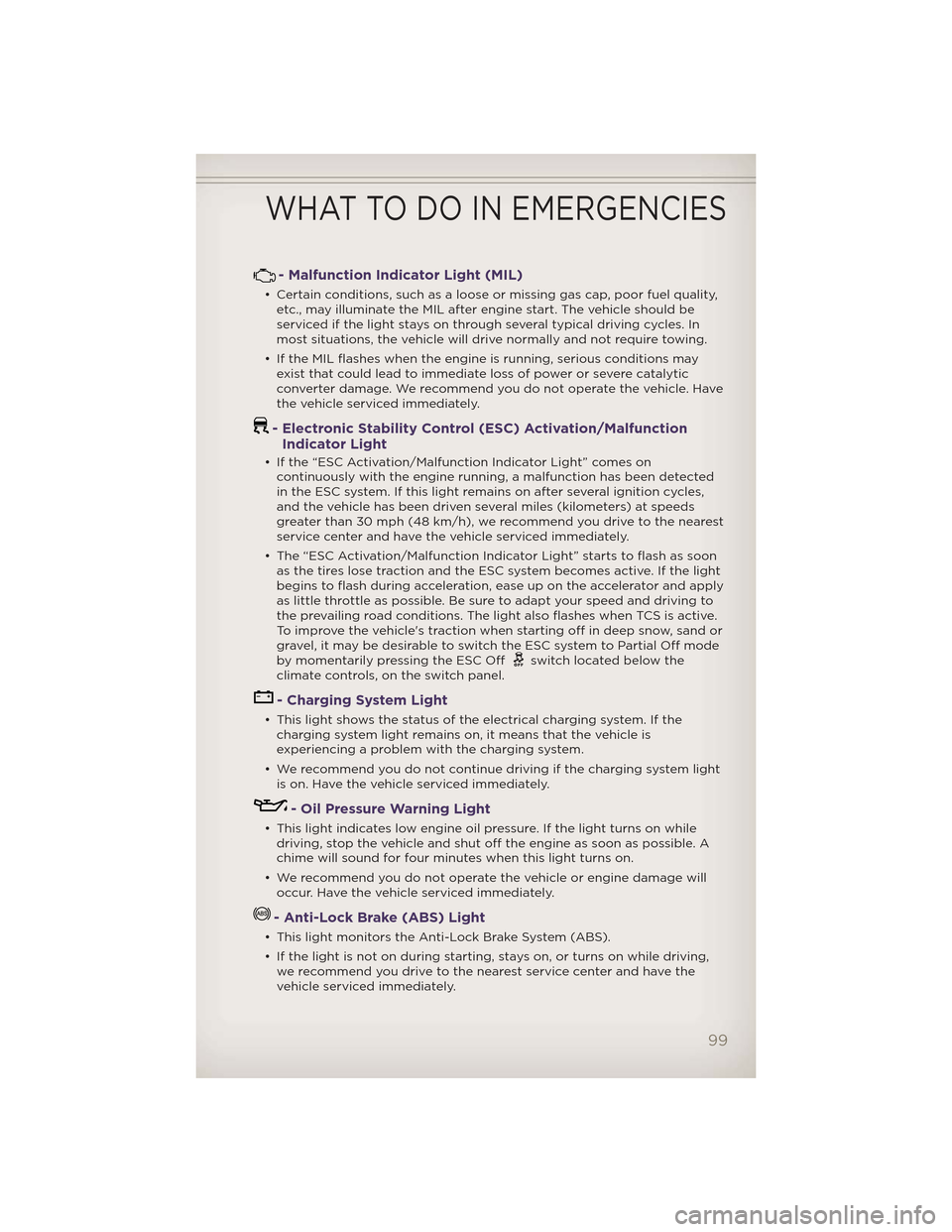
- Malfunction Indicator Light (MIL)
• Certain conditions, such as a loose or missing gas cap, poor fuel quality,etc., may illuminate the MIL after engine start. The vehicle should be
serviced if the light stays on through several typical driving cycles. In
most situations, the vehicle will drive normally and not require towing.
• If the MIL flashes when the engine is running, serious conditions may exist that could lead to immediate loss of power or severe catalytic
converter damage. We recommend you do not operate the vehicle. Have
the vehicle serviced immediately.
- Electronic Stability Control (ESC) Activation/MalfunctionIndicator Light
• If the “ESC Activation/Malfunction Indicator Light” comes on
continuously with the engine running, a malfunction has been detected
in the ESC system. If this light remains on after several ignition cycles,
and the vehicle has been driven several miles (kilometers) at speeds
greater than 30 mph (48 km/h), we recommend you drive to the nearest
service center and have the vehicle serviced immediately.
• The “ESC Activation/Malfunction Indicator Light” starts to flash as soon as the tires lose traction and the ESC system becomes active. If the light
begins to flash during acceleration, ease up on the accelerator and apply
as little throttle as possible. Be sure to adapt your speed and driving to
the prevailing road conditions. The light also flashes when TCS is active.
To improve the vehicle's traction when starting off in deep snow, sand or
gravel, it may be desirable to switch the ESC system to Partial Off mode
by momentarily pressing the ESC Off
switch located below the
climate controls, on the switch panel.
- Charging System Light
• This light shows the status of the electrical charging system. If the charging system light remains on, it means that the vehicle is
experiencing a problem with the charging system.
• We recommend you do not continue driving if the charging system light is on. Have the vehicle serviced immediately.
- Oil Pressure Warning Light
• This light indicates low engine oil pressure. If the light turns on whiledriving, stop the vehicle and shut off the engine as soon as possible. A
chime will sound for four minutes when this light turns on.
• We recommend you do not operate the vehicle or engine damage will occur. Have the vehicle serviced immediately.
- Anti-Lock Brake (ABS) Light
• This light monitors the Anti-Lock Brake System (ABS).
• If the light is not on during starting, stays on, or turns on while driving,we recommend you drive to the nearest service center and have the
vehicle serviced immediately.
WHAT TO DO IN EMERGENCIES
99
Page 102 of 148
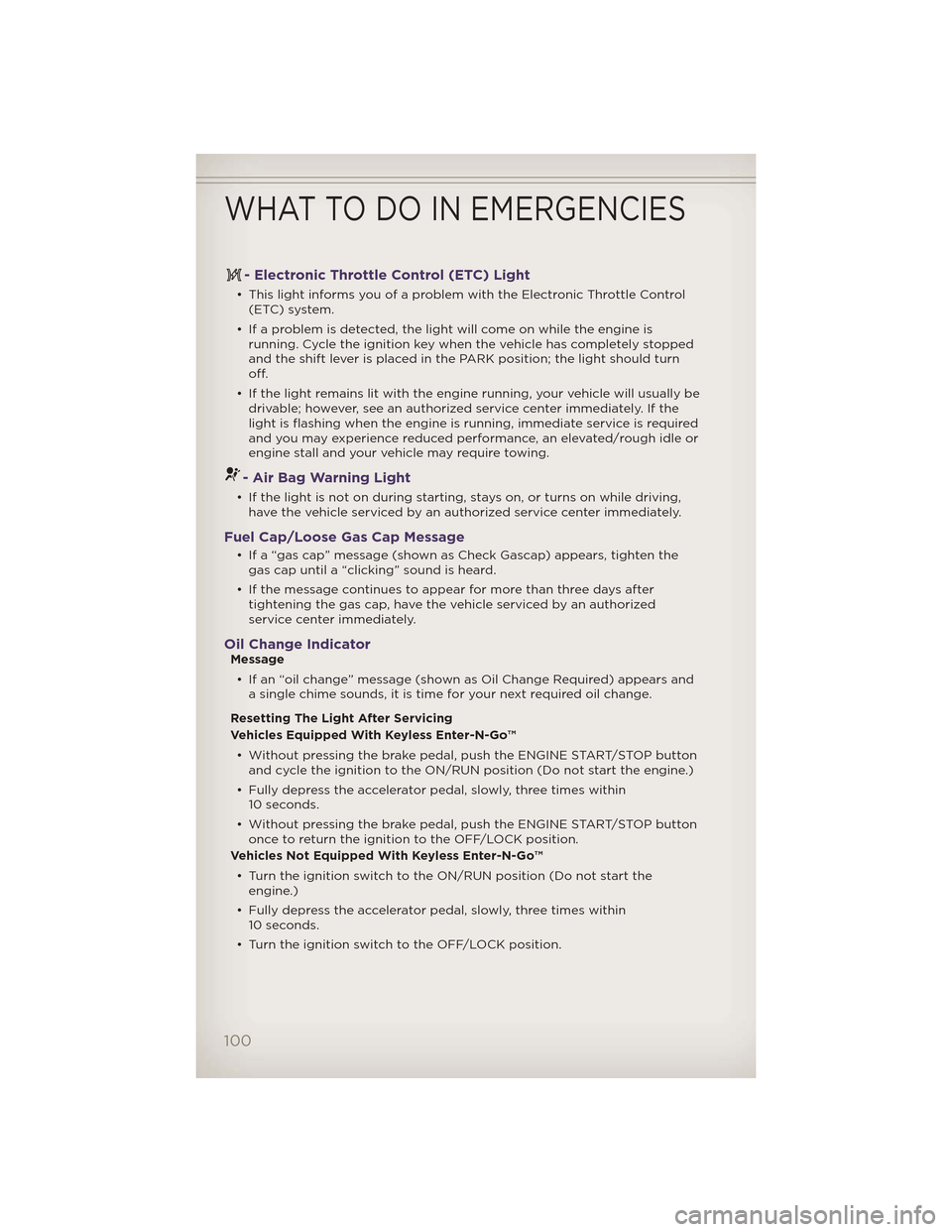
- Electronic Throttle Control (ETC) Light
• This light informs you of a problem with the Electronic Throttle Control(ETC) system.
• If a problem is detected, the light will come on while the engine is running. Cycle the ignition key when the vehicle has completely stopped
and the shift lever is placed in the PARK position; the light should turn
off.
• If the light remains lit with the engine running, your vehicle will usually be drivable; however, see an authorized service center i mmediately. If the
light is flashing when the engine is running, immediate service is required
and you may experience reduced performance, an elevated/rough idle or
engine stall and your vehicle may require towing.
- Air Bag Warning Light
• If the light is not on during starting, stays on, or turns on while driving, have the vehicle serviced by an authorized service center immediately.
Fuel Cap/Loose Gas Cap Message
• If a “gas cap” message (shown as Check Gascap) appears, tighten thegas cap until a “clicking” sound is heard.
• If the message continues to appear for more than three days after tightening the gas cap, have the vehicle serviced by an authorized
service center immediately.
Oil Change IndicatorMessage
• If an “oil change” message (shown as Oil Change Required) appears and a single chime sounds, it is time for your next required oil change.
Resetting The Light After Servicing
Vehicles Equipped With Keyless Enter-N-Go™ • Without pressing the brake pedal, push the ENGINE START/STOP button and cycle the ignition to the ON/RUN position (Do not start the engine.)
• Fully depress the accelerator pedal, slowly, three times within 10 seconds.
• Without pressing the brake pedal, push the ENGINE START/STOP button once to return the ignition to the OFF/LOCK position.
Vehicles Not Equipped With Keyless Enter-N-Go™
• Turn the ignition switch to the ON/RUN position (Do not start the engine.)
• Fully depress the accelerator pedal, slowly, three times within 10 seconds.
• Turn the ignition switch to the OFF/LOCK position.
WHAT TO DO IN EMERGENCIES
100
Page 104 of 148
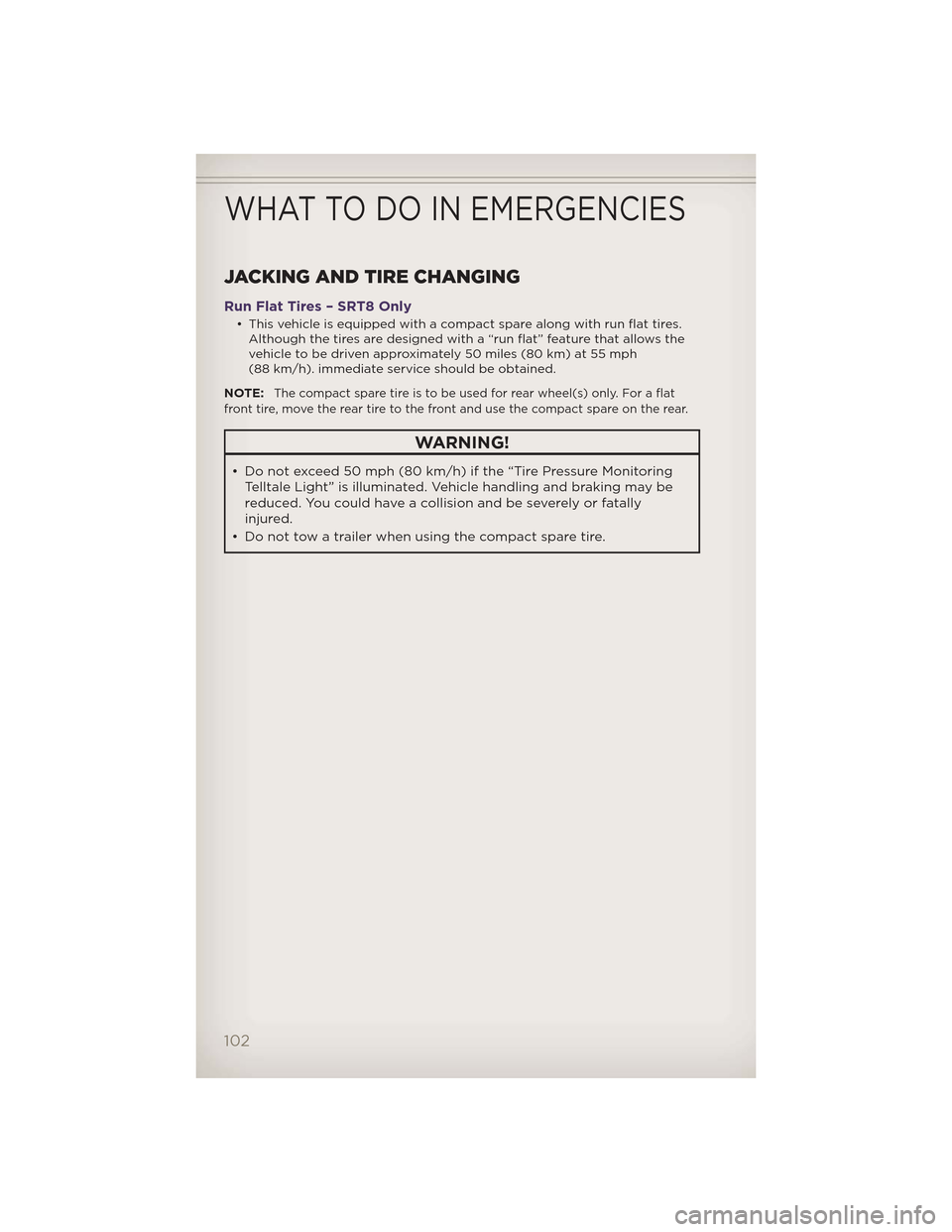
JACKING AND TIRE CHANGING
Run Flat Tires – SRT8 Only
• This vehicle is equipped with a compact spare along with run flat tires.Although the tires are designed with a “run flat” feature that allows the
vehicle to be driven approximately 50 miles (80 km) at 55 mph
(88 km/h). immediate service should be obtained.
NOTE:
The compact spare tire is to be used for rear wheel(s) only. For a flat
front tire, move the rear tire to the front and use the compact spare on the rear.
WARNING!
• Do not exceed 50 mph (80 km/h) if the “Tire Pressure Monitoring Telltale Light” is illuminated. Vehicle handling and braking may be
reduced. You could have a collision and be severely or fatally
injured.
• Do not tow a trailer when using the compact spare tire.
WHAT TO DO IN EMERGENCIES
102
Page 109 of 148
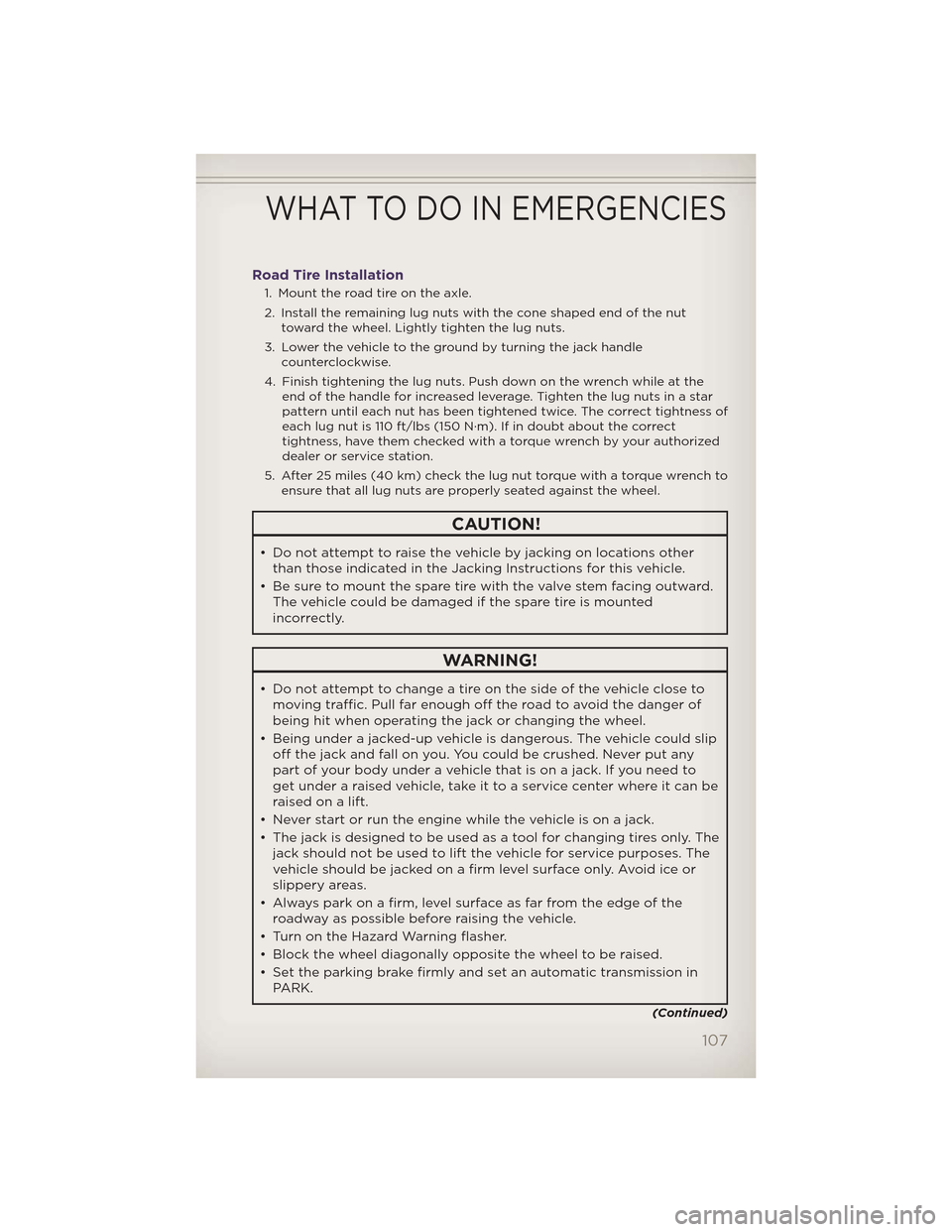
Road Tire Installation
1. Mount the road tire on the axle.
2. Install the remaining lug nuts with the cone shaped end of the nuttoward the wheel. Lightly tighten the lug nuts.
3. Lower the vehicle to the ground by turning the jack handle counterclockwise.
4. Finish tightening the lug nuts. Push down on the wrench while at the end of the handle for increased leverage. Tighten the lug nuts in a star
pattern until each nut has been tightened twice. The correct tightness of
each lug nut is 110 ft/lbs (150 N·m). If in doubt about the correct
tightness, have them checked with a torque wrench by your authorized
dealer or service station.
5. After 25 miles (40 km) check the lug nut torque with a torque wrench to ensure that all lug nuts are properly seated against the wheel.
CAUTION!
• Do not attempt to raise the vehicle by jacking on locations otherthan those indicated in the Jacking Instructions for this vehicle.
• Be sure to mount the spare tire with the valve stem facing outward. The vehicle could be damaged if the spare tire is mounted
incorrectly.
WARNING!
• Do not attempt to change a tire on the side of the vehicle close tomoving traffic. Pull far enough off the road to avoid the danger of
being hit when operating the jack or changing the wheel.
• Being under a jacked-up vehicle is dangerous. The vehicle could slip off the jack and fall on you. You could be crushed. Never put any
part of your body under a vehicle that is on a jack. If you need to
get under a raised vehicle, take it to a service center where it can be
raised on a lift.
• Never start or run the engine while the vehicle is on a jack.
• The jack is designed to be used as a tool for changing tires only. The jack should not be used to lift the vehicle for service purposes. The
vehicle should be jacked on a firm level surface only. Avoid ice or
slippery areas.
• Always park on a firm, level surface as far from the edge of the
roadway as possible before raising the vehicle.
• Turn on the Hazard Warning flasher.
• Block the wheel diagonally opposite the wheel to be raised.
• Set the parking brake firmly and set an automatic transmission in PARK.
(Continued)
WHAT TO DO IN EMERGENCIES
107
Page 116 of 148
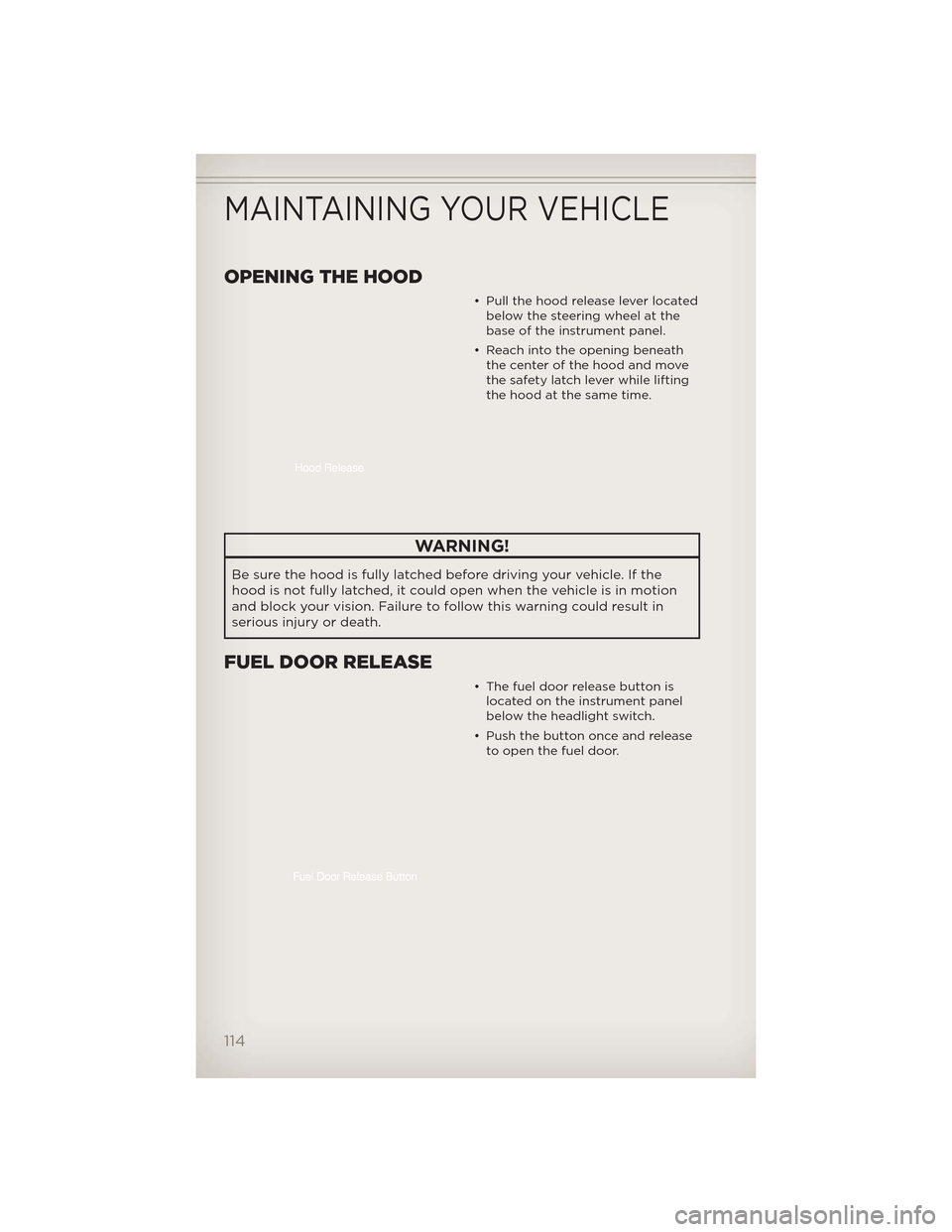
OPENING THE HOOD
• Pull the hood release lever locatedbelow the steering wheel at the
base of the instrument panel.
• Reach into the opening beneath the center of the hood and move
the safety latch lever while lifting
the hood at the same time.
WARNING!
Be sure the hood is fully latched before driving your vehicle. If the
hood is not fully latched, it could open when the vehicle is in motion
and block your vision. Failure to follow this warning could result in
serious injury or death.
FUEL DOOR RELEASE
• The fuel door release button islocated on the instrument panel
below the headlight switch.
• Push the button once and release to open the fuel door.
MAINTAINING YOUR VEHICLE
114
Page 137 of 148
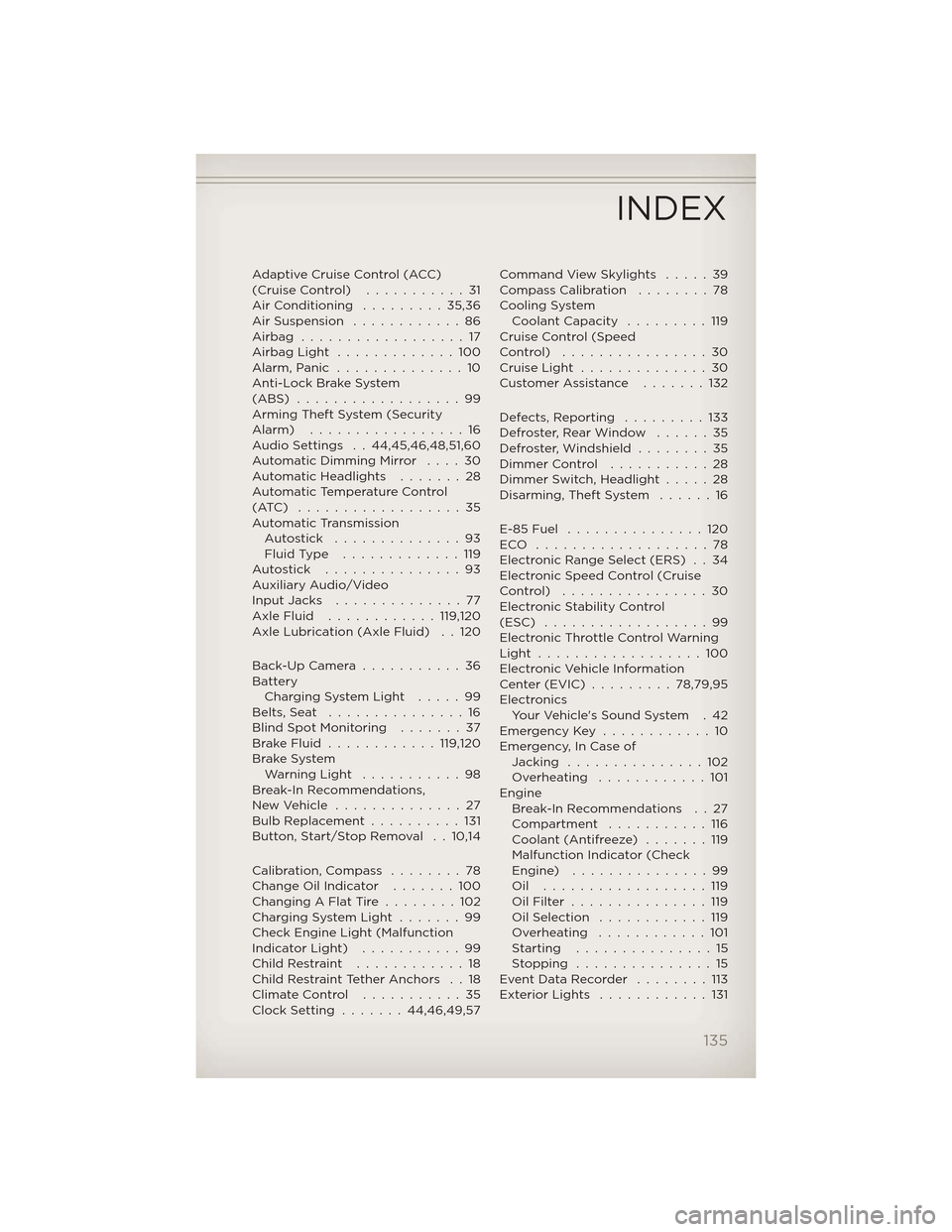
Adaptive Cruise Control (ACC)
(CruiseControl) ...........31
AirConditioning .........35,36
Air Suspension............86
Airbag ..................17
AirbagLight .............100
Alarm,Panic ..............10
Anti-Lock Brake System
(ABS) ..................99
Arming Theft System (Security
Alarm) .................16
Audio Settings . . 44,45,46,48,51,60
Automatic Dimming Mirror . . . . 30
Automatic Headlights .......28
Automatic Temperature Control
(ATC) ..................35
Automatic Transmission Autostick ..............93
FluidType .............119
Autostick ...............93
Auxiliary Audio/Video
Input Jacks ..............77
AxleFluid ............119,120
Axle Lubrication (Axle Fluid) . . 120
Back-Up Camera ...........36
Battery Charging System Light .....99
Belts, Seat ...............16
Blind Spot Monitoring . . . ....37
BrakeFluid ............119,120
Brake System WarningLight ...........98
Break-In Recommendations,
NewVehicle ..............27
Bulb Replacement ..........131
Button, Start/Stop Removal . . 10,14
Calibration, Compass ........78
Change Oil Indicator . . . . . . . 100
Changing A Flat Tire ........102
Charging System Light .......99
Check Engine Light (Malfunction
IndicatorLight) ...........99
ChildRestraint ............18
Child Restraint Tether Anchors . . 18
ClimateControl ...........35
Clock Setting .......44,46,49,57 Command View Skylights
.....39
Compass Calibration . . . . . . . . 78
Cooling System Coolant Capacity . . . . . ....119
Cruise Control (Speed
Control) ................30
CruiseLight ..............30
Customer Assistance . . . . . . . 132
Defects, Reporting . . . . . . . . . 133
Defroster, Rear Window . . . . . . 35
Defroster, Windshield . . . . . . . . 35
Dimmer Control . . . . . . . ....28
Dimmer Switch, Headlight . . . . . 28
Disarming, Theft System . . . . . . 16
E-85 Fuel . . . . . . . . . . . . . . . 120
ECO ...................78
Electronic Range Select (ERS) . . 34
Electronic Speed Control (Cruise
Control) ................30
Electronic Stability Control
(ESC) . . . . . . . . . . . . . . . . . . 99
Electronic Throttle Control Warning
Light ..................100
Electronic Vehicle Information
Center(EVIC).........78,79,95
Electronics Your Vehicle's Sound System . 42
Emergency Key . . . . . . . . . . . . 10
Emergency, In Case of Jacking . . . . . . . . . . . . . . . 102
Overheating . . . . . . . . . . . . 101
Engine Break-In Recommendations . . 27
Compartment . . . . . . . ....116
Coolant (Antifreeze) . . . . . . . 119
Malfunction Indicator (Check
Engine) . . . . . . . . . . . . . . . 99
Oil ..................119
OilFilter ...............119
OilSelection ............119
Overheating . . . . . . . . . . . . 101
Starting . . . . . . . . . . . . . . . 15
Stopping . . . . . . . . .......15
Event Data Recorder . . . . . . . . 113
ExteriorLights ............131
INDEX
135
Page 138 of 148
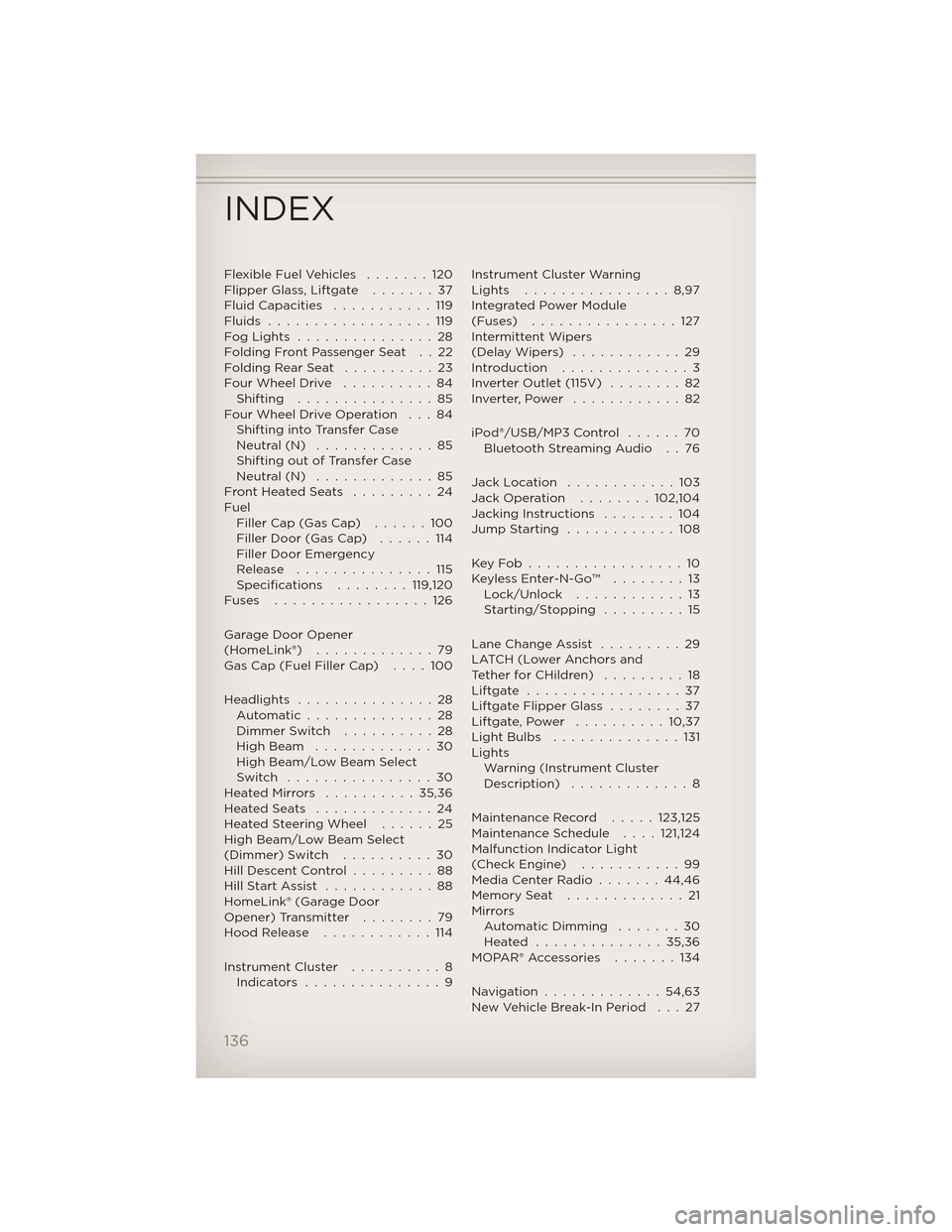
Flexible Fuel Vehicles.......120
Flipper Glass, Liftgate .......37
Fluid Capacities ...........119
Fluids ..................119
FogLights ...............28
Folding Front Passenger Seat . . 22
FoldingRearSeat ..........23
Four Wheel Drive ..........84
Shifting ...............85
Four Wheel Drive Operation . . . 84 Shifting into Transfer Case
Neutral (N) .............85
Shifting out of Transfer Case
Neutral (N) .............85
FrontHeatedSeats .........24
Fuel Filler Cap (Gas Cap) ......100
Filler Door (Gas Cap) ......114
Filler Door Emergency
Release ...............115
Specifications ........119,120
Fuses .................126
Garage Door Opener
(HomeLink®) .............79
Gas Cap (Fuel Filler Cap) . . . . 100
Headlights ...............28
Automatic..............28
Dimmer Switch ..........28
High Beam .............30
High Beam/Low Beam Select
Switch ................30
HeatedMirrors ..........35,36
HeatedSeats .............24
Heated Steering Wheel ......25
High Beam/Low Beam Select
(Dimmer) Switch ..........30
HillDescentControl.........88
HillStartAssist ............88
HomeLink® (Garage Door
Opener) Transmitter ........79
Hood Release ............114
Instrument Cluster ..........8
Indicators ...............9 Instrument Cluster Warning
Lights ................8,97
Integrated Power Module
(Fuses)
................127
Intermittent Wipers
(DelayWipers) ............29
Introduction . . . . . . . . . . . . . . 3
Inverter Outlet (115V) . . . . . . . . 82
Inverter,Power ............82
iPod®/USB/MP3 Control . . . . . . 70 Bluetooth Streaming Audio . . 76
Jack Location . . . . . . . . . . . . 103
Jack Operation . . . . . . . . 102,104
Jacking Instructions . . . . . . . . 104
Jump Starting . . . . . . . . . . . . 108
KeyFob.................10
KeylessEnter-N-Go™ ........13 Lock/Unlock . . . . . . . . . . . . 13
Starting/Stopping . . . . .....15
Lane Change Assist . . . . . . . . . 29
LATCH (Lower Anchors and
Tether for CHildren) . . . . . . . . . 18
Liftgate .................37
Liftgate Flipper Glass . . . . . . . . 37
Liftgate,Power ..........10,37
LightBulbs ..............131
Lights Warning (Instrument Cluster
Description) .............8
Maintenance Record . . . . . 123,125
Maintenance Schedule ....121,124
Malfunction Indicator Light
(Check Engine) . . . . . . . . . . . 99
Media Center Radio . . . . . . . 44,46
Memory Seat . . . . . . . . . . . . . 21
Mirrors Automatic Dimming . . . . . . . 30
Heated ..............35,36
MOPAR® Accessories . . . . . . . 134
Navigation.............54,63
New Vehicle Break-In Period . . . 27
INDEX
136